In this article, the authors show how AI agents can turn messy earnings call transcripts into...
With everything changing so quickly, finance teams can no longer afford to remain slow or rigid; agility in FP&A is crucial. Organizations face increasing pressure to respond swiftly to change, that is why they need to forecast accurately and move from insight to strategic action. The latest Digital North American FP&A Circle, titled “From Forecast to Action: Building Predictive Power into FP&A”, brought together finance leaders from Sony, Mars, High Liner Foods, and Wolters Kluwer CCH Tagetik to explore what it takes to embed predictive planning into FP&A processes.
From strategy-driven forecasting at Sony to AI-powered modeling at Mars, and from harmonized planning at High Liner Foods to scalable technology platforms, this session offered a variety of approaches and different angles on the topic. This article summarizes key takeaways and explores how predictive FP&A can empower finance teams.
Connecting Forecasts with Strategy
Yohei Kawazoe, Head of Corporate Strategy at Sony Europe, opened the session with a compelling statement: Planning and forecasting are not a strategy as such, but rather tools. Strategy and planning are closely connected, but it’s essential to pay attention to the planning horizon in relation to real market volatility.
Drawing on his experience leading turnaround strategies across Japan, the US, and Europe, Yohei outlined a disciplined monthly forecasting cadence at Sony Europe that supports both proactive short-term decision-making and alignment with strategy.
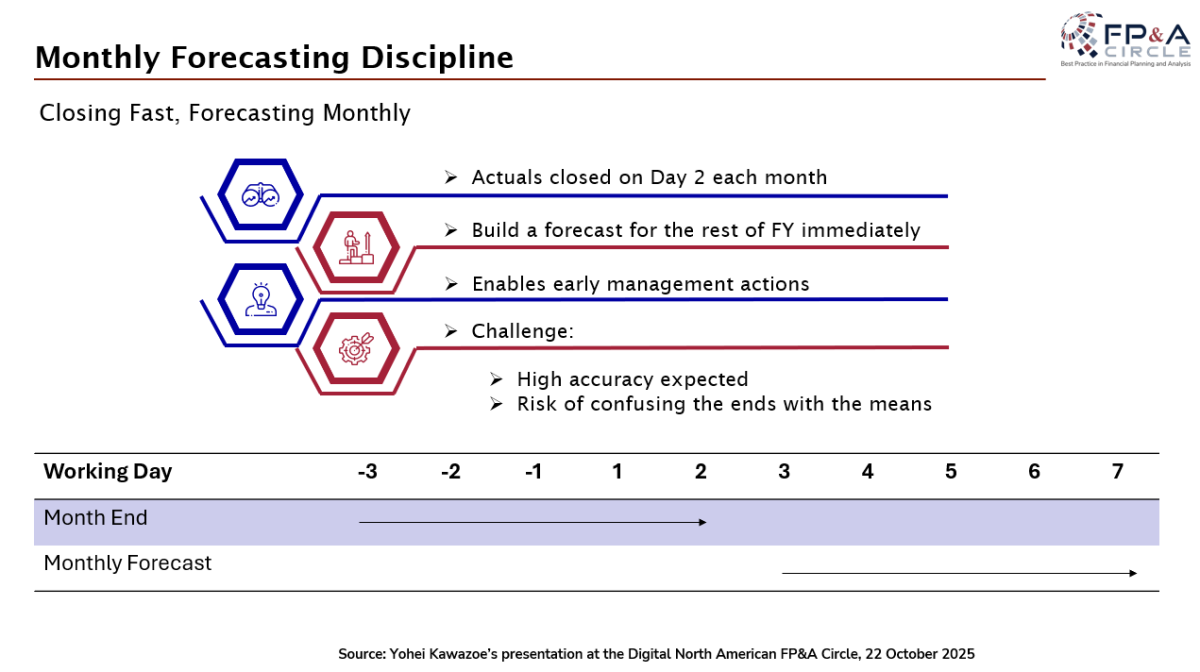
Figure 1
Key to Sony’s approach is linking short-term forecasts with mid- and long-term plans. Forecasts are not isolated exercises but part of a continuous planning framework anchored in a rolling three-year mid-range plan. Monthly forecasts, initiated just two days after the period close, allow for a quick response to market developments.
Yohei warned against the "planning trap" — an overemphasis on the planning process that affects execution. To avoid this, Sony emphasizes balance: discipline without rigidity, and speed without sacrificing strategic direction.
His closing insight: technology is an enabler, but value is unlocked through people — specifically, their insights, interpersonal skills, and ability to connect data with informed decisions.
Poll Insight: How Frequently Does Your Organization Update Forecasts?
44% of respondents update forecasts monthly, 7% bi-monthly, while 40% do so quarterly or less. Only 9% reported continuous or agile updates, highlighting that there is a significant opportunity for improvement.
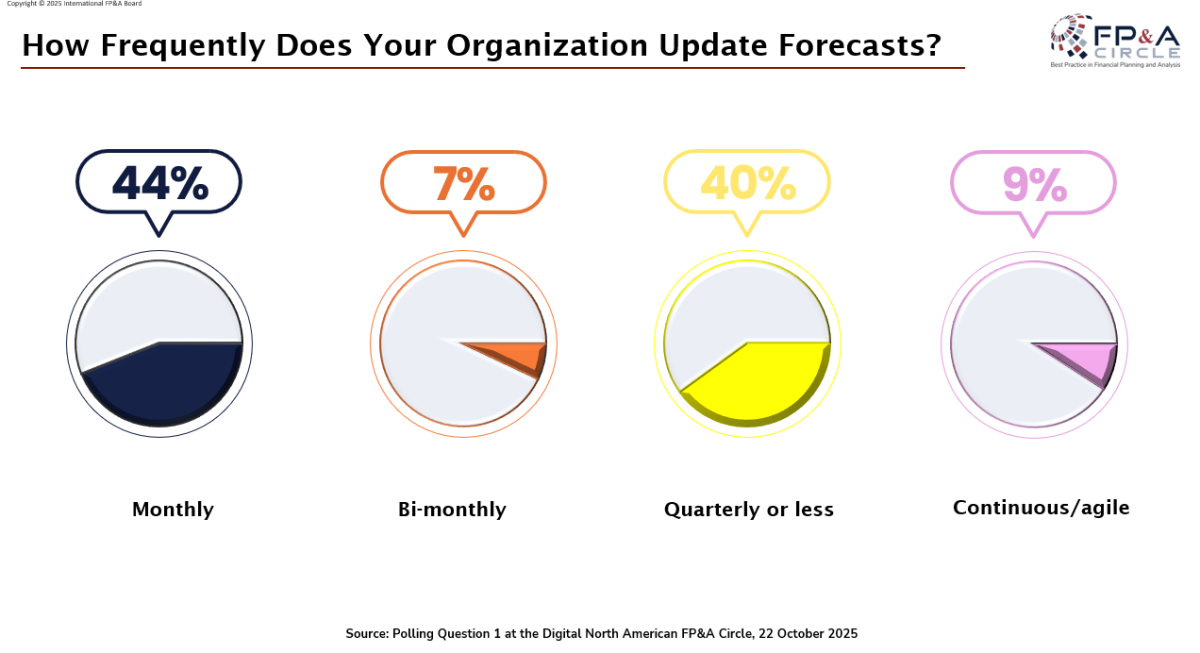
Figure 2
Building Predictive Power into FP&A at Mars
Oscar Lanner, Senior Director, Corporate FP&A at Mars, shared Mars’ journey to embed AI into forecasting processes. What began as a proof of concept 4-5 years ago has evolved into a scalable enterprise solution deployed across more than 40 business entities in the Mars environment. With forecast accuracy exceeding 95% across key metrics for P&L and Cash Flow, AI has significantly reduced manual effort and enabled scenario modeling and reporting at varying levels of granularity.
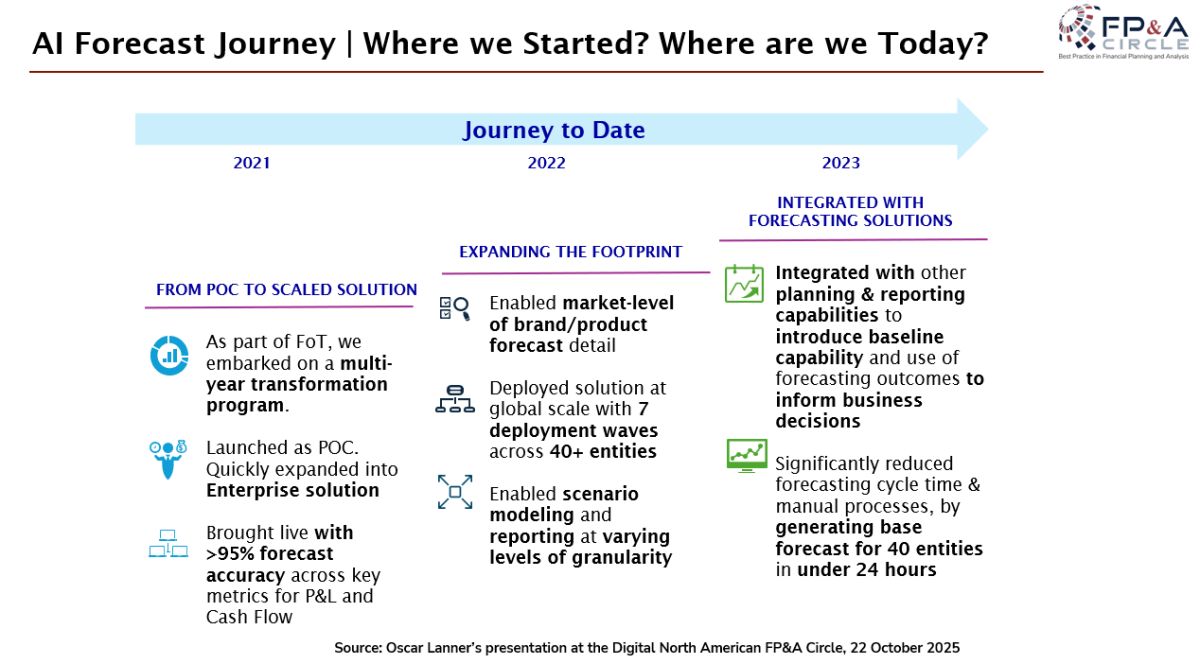
Figure 3
Despite this success, adoption was not immediate. Many finance associates were afraid of the "black box" nature of AI forecasts and preferred their old Excel-based models. Oscar emphasized the importance of transparency and education.
Mars now integrates AI forecasts into its planning processes as a baseline, allowing finance teams to focus on value-adding analysis and strategic conversations. The plan is to sharpen AI forecasts for future adoption, including:
- Demystify AI Forecasting
- Increase visibility into Drivers
- Engage business and stakeholders in the design
- Launch holistic change management to drive adoption
Oscar believes that by doing so, Mars will be able to bring the tool closer to the actual users, including finance users, as well as their own management, who will be more comfortable using the machine for their forecasts.
Poll Insight: What Stage is Your Team at in Implementing AI in Planning?
Nearly half of the audience (48%) reported that they haven’t started with AI yet. Another 33% are in the early stages of experimentation with AI, while 13% have partially implemented AI in specific areas. Only 6% of respondents indicated that AI is fully embedded into their FP&A processes.
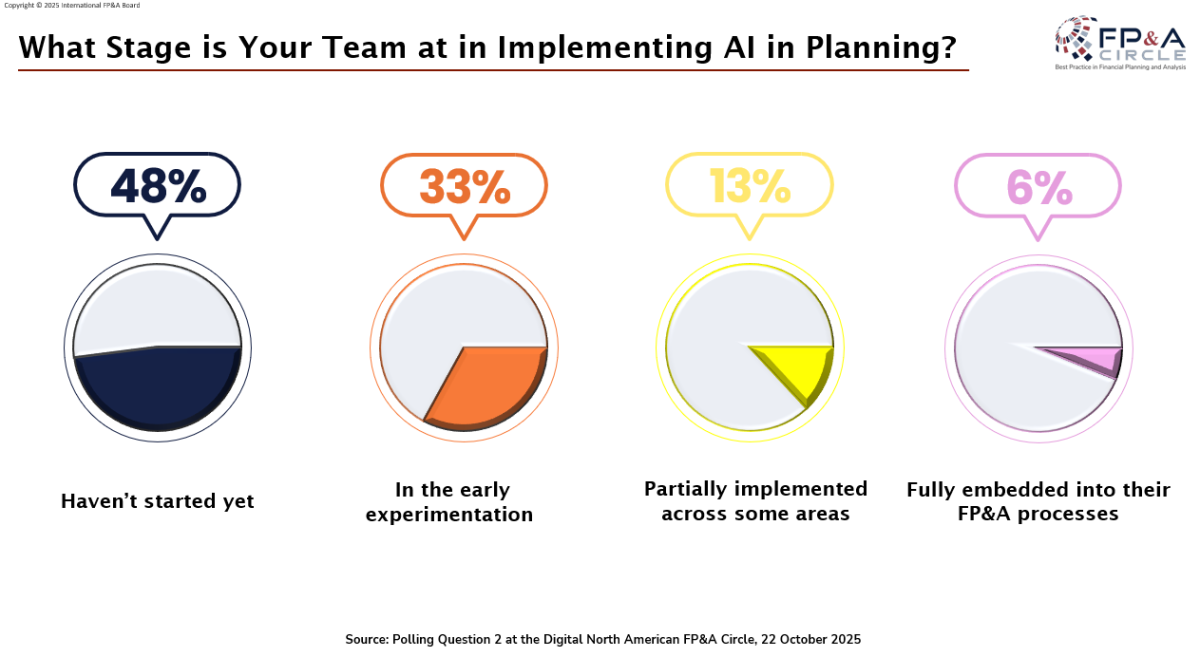
Figure 4
Harmonizing Planning in a Volatile Environment
Tammy Nisi, Director of FP&A Retail & Food Service North America at High Liner Foods, focused on the challenges of planning in an environment marked by inflation, supply chain instability, and evolving consumer behavior. At High Liner Foods, agility means harmonizing inputs from sales, marketing, and operations into a coherent forecasting process that reflects both internal drivers and market dynamics.
One of Tammy's key strategies is scenario planning based on cross-functional inputs. By integrating multiple perspectives, her team can better anticipate risks and opportunities. FP&A teams are no longer just number crunchers; they need to break down silos with other departments to truly understand and shape the financial forecast.
Tammy also highlighted the importance of forecast granularity: planning by channel, customer segment, and product category, to ensure relevance and precision.
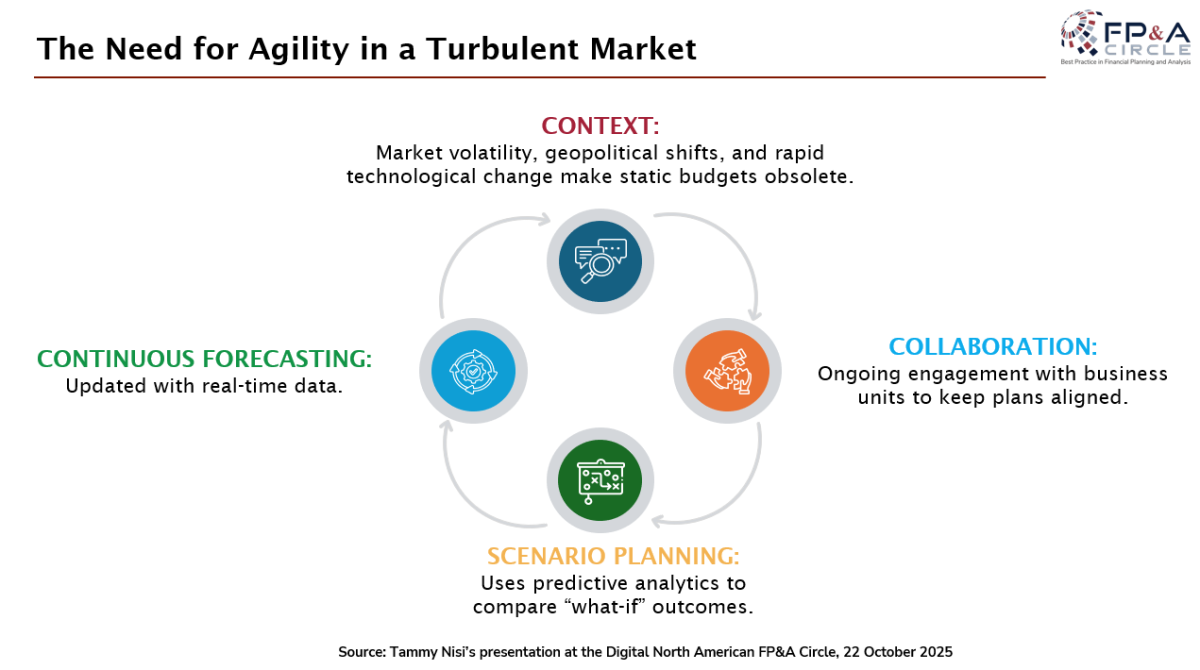
Figure 5
Tammy reinforced that flexibility and responsiveness are not just about models; they require strong collaboration and a clear understanding of the business.
Her final point: The future of FP&A is in predictive, harmonized, and agile planning.
Poll Insight: How Would You Describe Your Organization’s Current Level of Agility in Planning?
43% of respondents identified as moderately agile, while 37% described their teams as somewhat responsive. Meanwhile, 16% admitted to being very reactive, and only 4% considered their planning approach to be highly adaptive and forward-looking. These results suggest that while many teams are making strides toward agility, few have fully achieved a proactive, future-ready planning mindset.
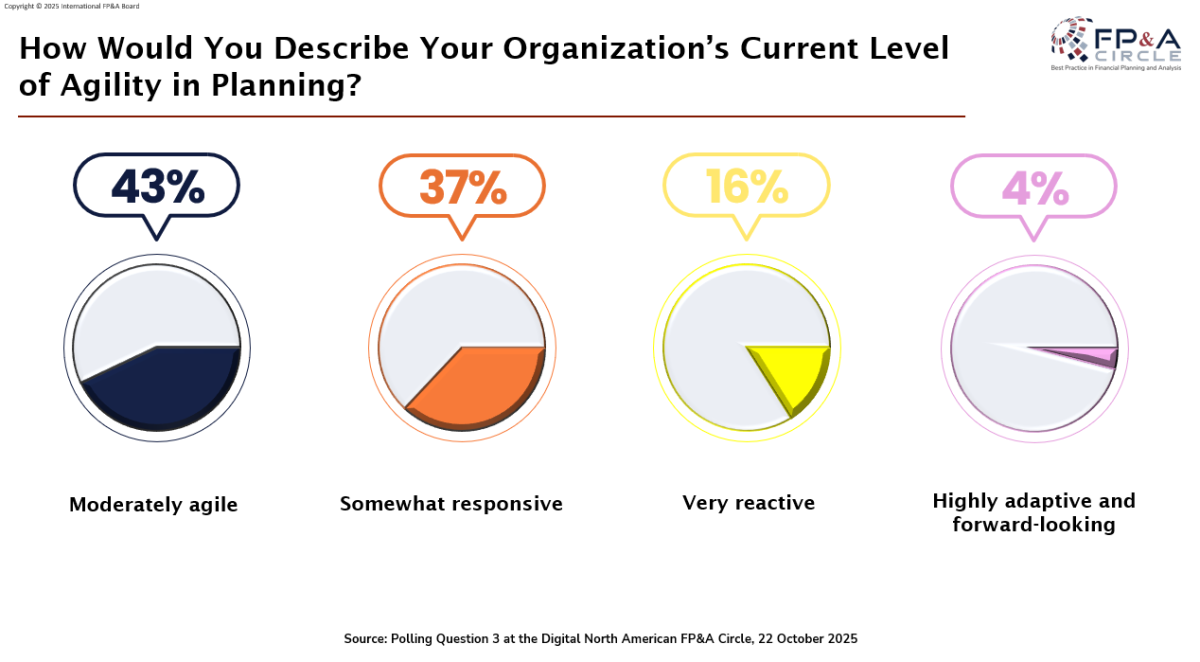
Figure 6
AI-Enabled Predictive Planning Through Customer Case Studies
Dominic Nguyen, FP&A Technology Advisor at Wolters Kluwer CCH Tagetik, highlighted the shift from static, manual forecasting to dynamic, AI-powered planning. He stressed that while budgeting is tactical, forecasting must be ongoing, fast, and strategic — enabled by technology but still reliant on human insight.
He shared three case studies:
- An automotive company used predictive planning to reach 98% forecast accuracy.
- A manufacturer reduced forecasting time across 167 products to just two hours.
- A large retail company used predictive planning to get to 99.6% accuracy for he full-year forecast
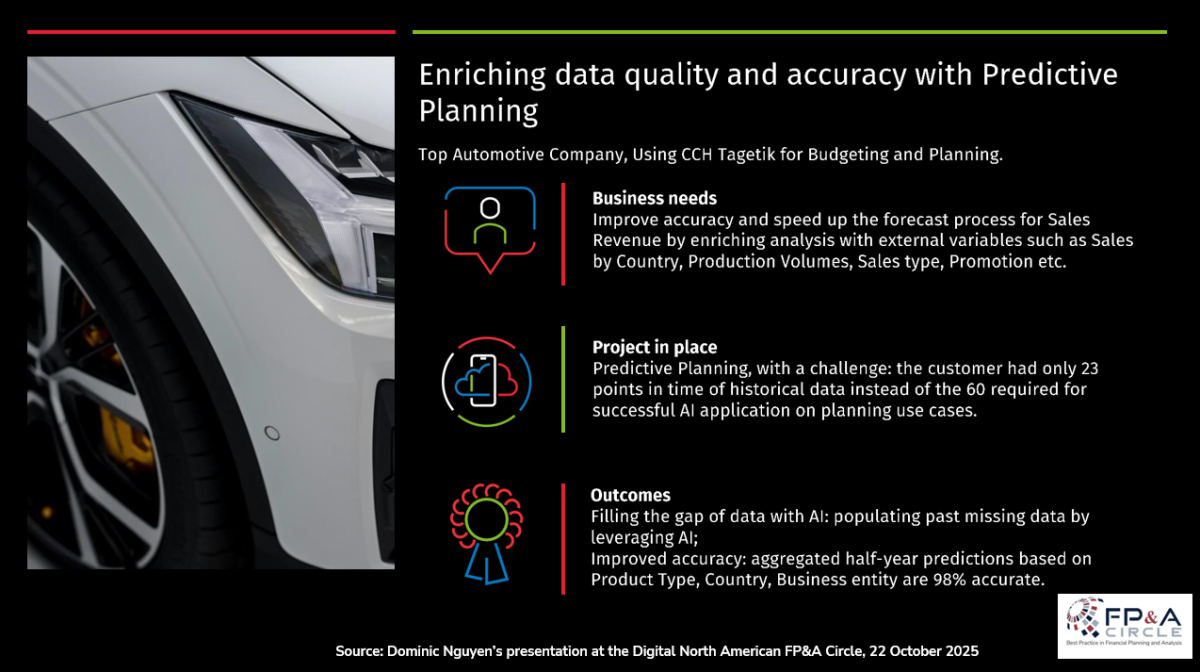
Figure 7
Modern planning tools significantly reduce manual preparation, speed up close cycles, and improve data integrity. They enhance governance by reducing the need for manual intervention, while also enabling a shift from retrospective reporting to proactive storytelling that supports better executive decision-making. Most importantly, they empower forward-looking planning without the need for constant manual recalibration.
Conclusion
This webinar has demonstrated that predictive power in FP&A requires speed, flexibility, proactiveness, and technology enablement. Organizations must connect planning to strategy, embed AI into planning without losing sight of human judgment, and prioritize collaboration with stakeholders.
AI adoption remains very low; FP&A teams play a critical role in change management and educating the rest of the business. The journey from forecast to action demands not only better forecasts, but a harmonized decision-making, planning and forecasting process supported by technology.
To watch the full webinar recording, please check out this link.
Subscribe to
FP&A Trends Digest

We will regularly update you on the latest trends and developments in FP&A. Take the opportunity to have articles written by finance thought leaders delivered directly to your inbox; watch compelling webinars; connect with like-minded professionals; and become a part of our global community.






